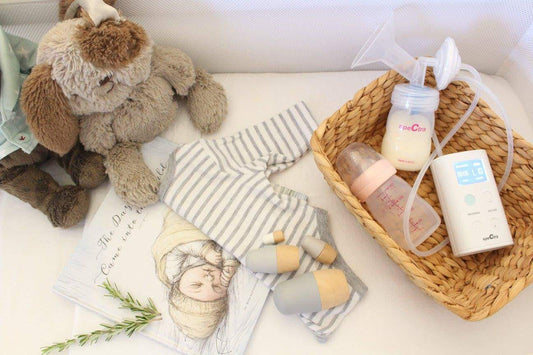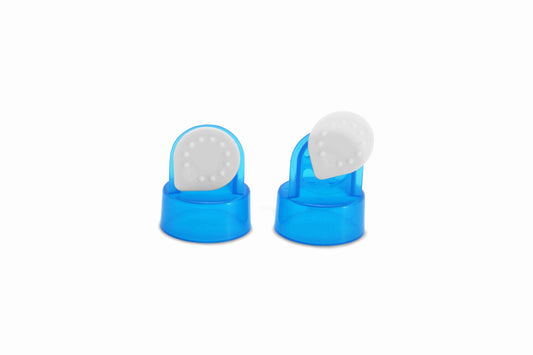1. How to train your body to respond to a breast pump
In the first 12 - 16 weeks after your baby's arrival, it's very important that you are expressing every 2 - 3 hours with no more than a 5 hour break overnight. This is to help stabilise your milk supply your milk supply for short and long term. Even if a mum has an over-supply in the early days, this will change when her hormones change after the first 3 - 4 months, and every month after that will have a gradual change making it a little harder for the body to respond to a breast pump. This is a time when no short cuts can happen. Generally these patterns mimic a baby's need for feeding, so it is not too different from the demands of a direct-latch fed newborn.

2. Take vigilance when adjusting your pumping routine
After the initial 12 - 16 weeks, you can slowly start to drop pumping sessions or spread them out throughout the day, but pay close attention to how your body responds so you can correct course if needed. By this point you will be a pro at this exclusive expressing gig; so don't worry about this too much if you're just starting. The important thing to know is that the intense period in the first 3 - 4 months will NOT last forever, and it WILL get easier!3. Pump beyond the point your breasts feel empty
You should pump until your breast feel empty and you see no or very little milkflow, which may take several letdowns, and then continue to pump for 5 minutes past this point. This lets your body know it needs to make more milk because your baby needs it!4. You need a hospital grade pump to exclusively express
You must use a hospital grade pump to exclusively express. Personal pumps are awesome when direct latch feeding is going well and pumping is for convenience only. Personal pumps will not have the same variety of settings required to drain a breast adequately, and they will not help you build supply. A hospital grade pump, such as the Spectra S1 or Spectra S2, with a variable cycle speed and letdown mode are crucial when you are exclusively expressing, and even more so as your baby gets older and it becomes harder to express.

Spectra S2 Hospital Grade Double Electric Breast Pump
5. Pay close attention to your diet
Your diet is very important to pay attention to when you are exclusively expressing, as your body needs all the help it can get to make good amounts of milk. It is not practical to be concerned about reducing calories for weight loss while exclusively expressing and trying to build a milk supply. You will want to include a good range of healthy fats and galactagogues in your diet to boost your supply, but also to add that nice creaminess to your milk for your baby. Make sure you are eating frequently throughout the day, and pay attention to what you eat, and the milk output soon after. You may consider keeping a food journal as you will start to see food and patterns that result in better milk output. You may even need a snack through the night to keep things working in the milk output department (we recommend keeping a couple easy snacks at your bedside table, such as granola bars, that you can grab if you're hungry in the middle of the night). Calories are your friend when it comes to good milk output, so ensure you are having more than enough. :)

6. Drink massive amounts of water
You will also need to drink massive amounts of water each day, and again, you will notice a difference in your milk output when you drink a good amount of water vs. an insufficient amount. It is not uncommon for exclusively pumping mamas to drink 3 - 4 litres of water per day! Especially in the early days, you might wake up in the middle of the night thirsty with a dry-mouth sensation. We recommend always keeping a full bottle of water at your night stand so you can easily quench your thirst at night.7. Use the best settings on your pump
Having the right tools to pump is essential. You will need to make sure you are using the settings on your pump to the best they can work for you, and if you need help learning what your pump can do for you, contact our team to point you in the right direction. We also have a great range of videos to help you assemble your shield kit, and to know how to operate your pump and get the best from it. Finding the right settings so often comes down to trial and error, and paying close attention to what better initiates letdown and draws more milk. It can be overwhelming at first, but after a few pumping sessions you will get the hang of it and it will become more routine.
8. Use the correct sized breastshield
It is really important that you have the best shield fit you can to exclusively express, as it has a significant impact on your output and supply. Measuring your nipple is the best place to start. If you need help determining the best shield fit for you, please ask our team for help!9. Replace your pump parts regularly
This is so important. A huge part of exclusively expressing is going to be changing your parts regularly. Worn out parts really impact how the pump performs, and as an exclusive pumper, negatively impact your milk supply. Many exclusively pumping mamas prefer the silicone duck valves over the valve-and-membrane sets because they are one piece, which makes it easier to clean and assemble. As a result, they tend to have more reliable suction performance, and last longer than the alternative. Many exclusively pumping mamas tend to grab their parts to last them for a few months, so that they always have spares, should a part become damaged or misplaced. Plus, they save on shipping (remember shipping is free for orders over $100!) by only placing a few large orders per year.

This is the first post in a series of articles about exclusively pumping - stay tuned for more. Spectra wants you to be successful along your pumping journey, so if you have any questions or concerns, our expert customer service team (including exclusively expressing mamas!) is here to help.




